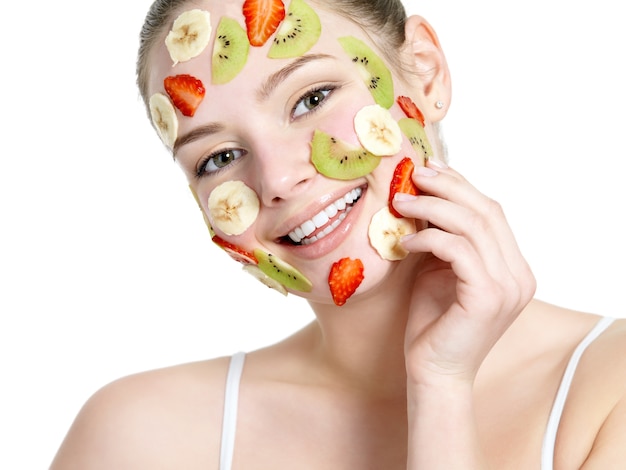A look at “11 DIY Fruit Face Masks For Glowing Skin For Oily Natural” Having glowing and healthy-looking skin is a desire shared by many. If you have oily skin, natural solutions can be a great way to achieve the desired results without the use of harsh chemicals. DIY fruit face masks can provide the nourishment and rejuvenation your skin needs while keeping oiliness at bay. In this article, we will explore 11 different fruit face mask recipes that can help you attain radiant and glowing skin.

Benefits of Fruit Face Masks
Fruit face masks offer a wide range of benefits for the skin. They are packed with vitamins, minerals, antioxidants, and natural acids that can help improve skin texture, tone, and overall appearance. Some of the benefits of using fruit face masks include:
- Hydration: Fruits are rich in water content, which helps hydrate the skin and maintain its moisture balance.
- Exfoliation: The natural enzymes present in fruits can gently exfoliate the skin, removing dead cells and revealing a fresh complexion.
- Brightening: Certain fruits contain natural bleaching properties that can help lighten dark spots and improve skin radiance.
- Oil Control: Many fruits possess astringent properties that can help regulate oil production, making them ideal for oily skin types.
- Anti-Aging: The antioxidants in fruits combat free radicals, reduce the signs of aging, and promote youthful-looking skin.
Choosing the Right Fruits for Your Skin
When selecting fruits for your DIY face masks, it’s essential to consider your skin type and its specific needs. For oily skin, you’ll want to choose fruits that help control excess oil and provide a refreshing effect. Some suitable fruits for oily skin include:
- Citrus fruits (lemon, orange, grapefruit): These fruits have astringent properties and can help control oiliness.
- Berries (strawberries, blueberries): Rich in antioxidants, berries can combat free radicals and brighten the skin.
- Papaya: This tropical fruit contains natural enzymes that exfoliate and rejuvenate oily skin.
- Pineapple: With its enzyme bromelain, pineapple can help cleanse pores and reduce oiliness.
- Kiwi: Kiwi is packed with vitamins C and E, which can promote a healthy complexion.
DIY Fruit Face Mask Recipes
Banana and Honey Face Mask
Ingredients:
- 1 ripe banana
- 1 tablespoon honey
Instructions:
- Mash the ripe banana in a bowl until it becomes a smooth paste.
- Add honey to the banana paste and mix well.
- Apply the mixture evenly to your face and neck, avoiding the eye area.
- Leave the mask on for 15-20 minutes.
- Rinse off with lukewarm water and pat dry.
- Enjoy the nourishing and hydrating benefits of this mask, which will leave your skin glowing and refreshed.
Papaya and Lemon Face Mask
Ingredients:
- ½ cup mashed papaya
- 1 teaspoon lemon juice
Instructions:
- In a bowl, combine the mashed papaya and lemon juice.
- Mix well until you have a consistent paste.
- Apply the mask to your face, avoiding the eye area.
- Leave it on for 15 minutes.
- Rinse off with cool water and gently pat dry.
- This mask will help exfoliate dead skin cells and brighten your complexion.
Strawberry and Yogurt Face Mask
Ingredients:
- 3-4 ripe strawberries
- 2 tablespoons yogurt
Instructions:
- Mash the strawberries in a bowl until smooth.
- Add yogurt to the mashed strawberries and mix well.
- Apply the mixture to your face and neck using gentle circular motions.
- Leave the mask on for 20 minutes.
- Rinse off with lukewarm water and pat your skin dry.
- This mask will help tighten pores and leave your skin feeling refreshed and rejuvenated.
Orange and Turmeric Face Mask
Ingredients:
- 2 tablespoons orange juice
- ½ teaspoon turmeric powder
Instructions:
- In a bowl, combine the orange juice and turmeric powder.
- Mix well until you have a smooth paste.
- Apply the mask to your face and neck, avoiding the eye area.
- Leave it on for 15-20 minutes.
- Rinse off with cool water and pat your skin dry.
- This mask will help brighten your skin tone and reduce excess oil.
Pineapple and Cucumber Face Mask
Ingredients:
- ½ cup chopped pineapple
- ¼ cup cucumber slices
Instructions:
- Blend the chopped pineapple and cucumber slices in a blender until smooth.
- Apply the mixture to your face, avoiding the eye area.
- Leave the mask on for 15 minutes.
- Rinse off with cool water and pat your skin dry.
- This mask will help cleanse and tighten your pores, leaving your skin refreshed and revitalized.
Watermelon and Mint Face Mask
Ingredients:
- ½ cup mashed watermelon
- 1 tablespoon chopped fresh mint leaves
Instructions:
- In a bowl, combine the mashed watermelon and chopped mint leaves.
- Mix well to form a paste.
- Apply the mask to your face and neck.
- Leave it on for 20 minutes.
- Rinse off with lukewarm water and pat dry.
- This mask will help hydrate and soothe your skin, giving it a natural glow.
Kiwi and Aloe Vera Face Mask
Ingredients:
READ RELATED: How Many Shares of Amazon Does Jeff Bezos Own? After Selling $10 Billion Worth of Amazon Stock
- 1 ripe kiwi
- 1 tablespoon aloe vera gel
Instructions:
- Peel the kiwi and mash it in a bowl until smooth.
- Add aloe vera gel to the mashed kiwi and mix well.
- Apply the mixture to your face, avoiding the eye area.
- Leave it on for 15-20 minutes.
- Rinse off with cool water and gently pat dry.
- This mask will help rejuvenate and nourish your skin, leaving it with a natural glow.
Grapefruit and Oatmeal Face Mask
Ingredients:
- ½ grapefruit, juiced
- 2 tablespoons oatmeal
Instructions:
- In a bowl, combine the grapefruit juice and oatmeal.
- Mix well until you have a thick paste.
- Apply the mask to your face and neck.
- Leave it on for 15 minutes.
- Rinse off with lukewarm water and pat your skin dry.
- This mask will help exfoliate and brighten your skin, giving it a healthy radiance.
Mango and Coconut Oil Face Mask
Ingredients:
- ½ ripe mango, mashed
- 1 tablespoon coconut oil
Instructions:
- Mash the ripe mango in a bowl until smooth.
- Add coconut oil to the mashed mango and mix well.
- Apply the mixture to your face and neck.
- Leave it on for 20 minutes.
- Rinse off with cool water and gently pat dry.
- This mask will provide deep hydration and nourishment to your skin, leaving it soft and glowing.
Apple and Green Tea Face Mask
Ingredients:
- 1 small apple, grated
- 1 green tea bag, steeped in hot water and cooled
Instructions:
- In a bowl, combine the grated apple and cooled green tea.
- Mix well until you have a paste-like consistency.
- Apply the mask to your face, avoiding the eye area.
- Leave it on for 15-20 minutes.
- Rinse off with lukewarm water and pat your skin dry.
- This mask will help tone and rejuvenate your skin, giving it a youthful glow.
Pomegranate and Rosewater Face Mask
Ingredients:
- ¼ cup pomegranate seeds, crushed
- 2 tablespoons rosewater
Instructions:
- Crush the pomegranate seeds in a bowl.
- Add rosewater to the crushed seeds and mix well.
- Apply the mixture to your face and neck.
- Leave it on for 15 minutes.
- Rinse off with cool water and gently pat dry.
- This mask will help brighten and revitalize your skin, giving it a natural radiance.
Applying Fruit Face Masks

To apply fruit face masks effectively, follow these steps:
- Start with a clean and dry face.
- Gently apply the chosen fruit face mask using your fingertips or a brush, ensuring even coverage.
- Avoid the eye area and sensitive areas of the skin.
- Relax and leave the mask on for the recommended time mentioned in the respective recipes.
- Rinse off the mask thoroughly with lukewarm water.
- Pat your skin dry with a soft towel.
- Follow up with your regular skincare routine, such as moisturizing.
Precautions and Tips
When using fruit face masks, keep the following precautions and tips in mind:
- Patch Test: Before applying any new fruit or ingredient to your face, perform a patch test on a small area of your skin to check for any allergic reactions.
- Fresh Fruits: Use fresh fruits for maximum effectiveness and avoid using fruits that have gone bad or are overripe.
- Consistency: Apply the fruit face masks regularly for best results. Consistency is key to achieving healthy and glowing skin.
- Organic and Locally Sourced: Whenever possible, choose organic fruits that are free from pesticides and chemicals. Additionally, sourcing locally can ensure the freshness and quality of the fruits.
- Customize for Your Skin: Feel free to customize the fruit face mask recipes according to your skin’s specific needs. You can add ingredients like yogurt, honey, or aloe vera to enhance the benefits or address specific concerns.
- Massage and Relax: While applying the mask, gently massage it into your skin using circular motions. This can help stimulate blood circulation and improve absorption of the mask’s nutrients. Take this time to relax and unwind.
- Sun Protection: After using fruit face masks, it’s important to apply sunscreen to protect your skin from harmful UV rays. Fruits contain natural acids that can make your skin more sensitive to the sun.
- Hydration: Remember to drink plenty of water throughout the day to keep your skin hydrated from within. Hydration is essential for maintaining healthy and glowing skin.
Key Takeaways

- DIY fruit face masks are a natural and effective way to achieve glowing and nourished skin.
- There are various fruit options available, each with its own unique benefits for the skin.
- Using fresh and organic fruits is recommended for maximum effectiveness.
- Customizing fruit face mask recipes allows you to address specific skin concerns.
- Consistency in using fruit face masks is important for optimal results.
- Gently massaging the mask into the skin can improve blood circulation and nutrient absorption.
- It’s essential to protect the skin from the sun after using fruit face masks.
- Staying hydrated by drinking water is crucial for maintaining healthy skin.
- Fruit face masks can be suitable for all skin types, but it’s important to choose fruits according to individual needs.
- Freshly prepared masks are preferred over storing leftover mixtures.
- Fruit face masks can complement your regular skincare routine but should not replace essential steps like cleansing and moisturizing.
Conclusion
Incorporating DIY fruit face masks into your skincare routine can be a wonderful way to achieve glowing and nourished skin. With the wide variety of fruits available, you can customize the masks to suit your skin’s needs and preferences. Whether you have oily skin or are looking for natural remedies, these 11 fruit face mask recipes offer an array of benefits. Remember to be consistent, enjoy the process, and embrace the natural goodness of fruits for a radiant complexion.
FAQs
- Are fruit face masks suitable for all skin types?
- Yes, fruit face masks can be beneficial for all skin types. However, it’s important to choose fruits that are suitable for your specific skin concerns. For example, oily skin types can benefit from fruits with astringent properties.
- How often should I use fruit face masks?
- You can use fruit face masks 2-3 times a week for best results. However, it’s important to observe how your skin responds and adjust the frequency accordingly.
- Can I store leftover fruit face mask mixtures?
- It’s recommended to prepare fresh fruit face masks for each use to ensure maximum effectiveness. Leftover mixtures may lose their potency or become contaminated.
- Can I combine different fruits in one face mask?
- Yes, you can experiment with combining different fruits to create unique blends. Just make sure to consider the properties and benefits of each fruit before mixing.
- Can fruit face masks replace my regular skincare routine?
- Fruit face masks can be a beneficial addition to your regular skincare routine, but they should not replace essential steps like cleansing, toning, and moisturizing.
Here are some of the sources I used for this response:
I hope this helps!
You may also like | Increase Fat Intake on Keto: 15 Easy Tips to Hit Your Targets




